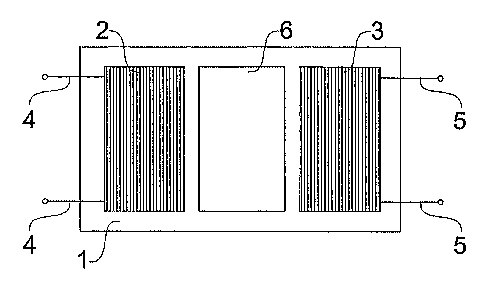Some of the information on this Web page has been provided by external sources. The Government of Canada is not responsible for the accuracy, reliability or currency of the information supplied by external sources. Users wishing to rely upon this information should consult directly with the source of the information. Content provided by external sources is not subject to official languages, privacy and accessibility requirements.
Any discrepancies in the text and image of the Claims and Abstract are due to differing posting times. Text of the Claims and Abstract are posted:
| (12) Patent Application: | (11) CA 2581260 |
|---|---|
| (54) English Title: | SURFACE ACOUSTIC WAVE GAS SENSOR WITH SENSITIVE GETTER LAYER AND PROCESS FOR ITS MANUFACTURE |
| (54) French Title: | CAPTEUR DE GAZ A ONDE ACOUSTIQUE DE SURFACE COMPRENANT UNE COUCHE DE GETTER SENSIBLE ET PROCEDE PERMETTANT DE FABRIQUER CE CAPTEUR |
| Status: | Deemed Abandoned and Beyond the Period of Reinstatement - Pending Response to Notice of Disregarded Communication |
| (51) International Patent Classification (IPC): |
|
|---|---|
| (72) Inventors : |
|
| (73) Owners : |
|
| (71) Applicants : |
|
| (74) Agent: | GOWLING WLG (CANADA) LLP |
| (74) Associate agent: | |
| (45) Issued: | |
| (86) PCT Filing Date: | 2005-10-17 |
| (87) Open to Public Inspection: | 2006-04-27 |
| Availability of licence: | N/A |
| Dedicated to the Public: | N/A |
| (25) Language of filing: | English |
| Patent Cooperation Treaty (PCT): | Yes |
|---|---|
| (86) PCT Filing Number: | PCT/IT2005/000605 |
| (87) International Publication Number: | WO 2006043299 |
| (85) National Entry: | 2007-03-21 |
| (30) Application Priority Data: | ||||||
|---|---|---|---|---|---|---|
|
Surface acoustic wave gas sensor, in particular a vacuum or hydrogen sensor,
comprising a piezoelectric substrate (1) on which at least one layer of a gas-
sensitive material (6) is arranged between two inter-digital transducers (2,
3) and comprises a getter material, so that the molecules sorbed by this
getter material can vary the frequency of a signal transmitted between the two
transducers (2, 3). The present invention also relates to a process for
manufacturing this sensor.
L'invention concerne un capteur de gaz à onde acoustique de surface, en particulier un capteur d'hydrogène ou un capteur de dépression, comprenant un substrat (1) piézoélectrique sur lequel est appliquée au moins une couche de matériau (6) sensible aux gaz intercalée entre deux transducteurs (2, 3) interdigités, et comprenant un getter, de telle manière que les molécules sorbées par le getter produisent une modification de la fréquence d'un signal transmis entre les deux transducteurs (2, 3). La présente invention se rapporte également à un procédé permettant de fabriquer ce capteur.
Note: Claims are shown in the official language in which they were submitted.
Note: Descriptions are shown in the official language in which they were submitted.

2024-08-01:As part of the Next Generation Patents (NGP) transition, the Canadian Patents Database (CPD) now contains a more detailed Event History, which replicates the Event Log of our new back-office solution.
Please note that "Inactive:" events refers to events no longer in use in our new back-office solution.
For a clearer understanding of the status of the application/patent presented on this page, the site Disclaimer , as well as the definitions for Patent , Event History , Maintenance Fee and Payment History should be consulted.
| Description | Date |
|---|---|
| Time Limit for Reversal Expired | 2010-10-18 |
| Application Not Reinstated by Deadline | 2010-10-18 |
| Deemed Abandoned - Failure to Respond to Maintenance Fee Notice | 2009-10-19 |
| Inactive: Cover page published | 2007-05-31 |
| Letter Sent | 2007-05-16 |
| Inactive: Notice - National entry - No RFE | 2007-05-16 |
| Application Received - PCT | 2007-04-13 |
| National Entry Requirements Determined Compliant | 2007-03-21 |
| Application Published (Open to Public Inspection) | 2006-04-27 |
| Abandonment Date | Reason | Reinstatement Date |
|---|---|---|
| 2009-10-19 |
The last payment was received on 2008-09-23
Note : If the full payment has not been received on or before the date indicated, a further fee may be required which may be one of the following
Please refer to the CIPO Patent Fees web page to see all current fee amounts.
| Fee Type | Anniversary Year | Due Date | Paid Date |
|---|---|---|---|
| Basic national fee - standard | 2007-03-21 | ||
| Registration of a document | 2007-03-21 | ||
| MF (application, 2nd anniv.) - standard | 02 | 2007-10-17 | 2007-09-24 |
| MF (application, 3rd anniv.) - standard | 03 | 2008-10-17 | 2008-09-23 |
Note: Records showing the ownership history in alphabetical order.
| Current Owners on Record |
|---|
| SAES GETTERS S.P.A. |
| Past Owners on Record |
|---|
| MARCO AMIOTTI |